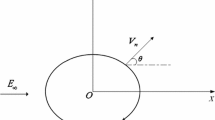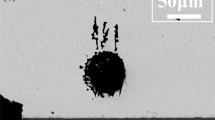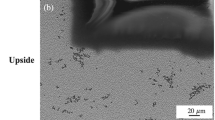Abstract
Electromigration in electrical interconnects with high current density causes voids to form and grow near the cathode. These voids can possibly grow large enough to cause open circuit failure. The simulation of electromigration void nucleation and growth is challenging because of the complex interaction of electrical, thermal and mechanical fields that lead to the observed voids. In this paper, a phase-field approach is developed to study void growth due to electromigration taking into account diffusional anisotropy and specified contact angle. Consideration of anisotropy and contact angle is critical in applications including electronic assemblies that most commonly use Sn-based solder interconnects. In such systems, Sn exhibits significant anisotropy in its self-diffusivity, which assumes importance in small solder joints that are known to contain only a few grains. Furthermore, the contact angle at the void-bonding pad-solder triple junction is known to influence the void size and shape. To the best of the authors’ knowledge, only anisotropy in surface diffusivity has been considered in phase-field electromigration literature, whereas the contact angle at a triple junction has not been considered. The developed phase-field model incorporates effects of both contact angle and anisotropy in self-diffusivity. The model is used to simulate systems with different contact angles and dominant directions of diffusion. It is observed that diffusional anisotropy plays a more dominant role in failure, while the contact angle dictates evolution of the shape of voids.












Similar content being viewed by others
References
Bieler T, Jiang H, Lehman L, Kirkpatrick T, Cotts E (2006) Influence of Sn grain size and orientation on the thermomechanical response and reliability of Pb-free solder joints. In: Proceedings of the electronic components and technology conference, pp 1462–1467
Chen C, Tong H, Tu K (2010) Electromigration and thermomigration in pb-free flip-chip solder joints. Annu Rev Mater Res 40:531–555
Zhang L, Ou S, Huang J, Tu KN, Gee S, Nguyen L (2006) Effect of current crowding on void propagation at the interface between intermetallic compound and solder in flip chip solder joints. Appl Phys Lett 88(1):012106
Basaran C, Lin M, Ye H (2003) A thermodynamic model for electrical current induced damage. Int J Solids Struct 40(26):7315–7327
Basaran C, Lin M (2008) Damage mechanics of electromigration induced failure. Mech Mater 40:66–79. https://doi.org/10.1016/j.mechmat.2007.06.006
Rice JR, Drucker DC (1967) Energy C in stressed bodies due to void and crack growth. Int J Fract 3(1):19–27. https://doi.org/10.1007/BF00188642
Lin M, Basaran C (2005) Electromigration induced stress analysis using fully coupled mechanical—diffusion equations with nonlinear material properties. Comput Mater Sci 34:82–98. https://doi.org/10.1016/j.commatsci.2004.10.007
Liu Y, Zhang Y, Liang L (2010) Prediction of electromigration induced voids and time to failure for solder joint of a wafer level chip scale package. IEEE Trans Compon Packag Technol 33(3):544–552. https://doi.org/10.1109/TCAPT.2010.2042717
Park M, Gibbons S, Arróyave R (2013) Phase-field simulations of intermetallic compound evolution in cu/sn solder joints under electromigration. Acta Mater 61(19):7142–7154
Udupa A, Sadasiva S, Subbarayan G (2016) A framework for studying dynamics and stability of diffusive-reactive interfaces with application to cu6sn5 intermetallic compound growth. Proc R Soc A Math Phys Eng Sci 472(2190):20160134
Kassner K, Misbah C (1999) A phase-field approach for stress-induced instabilities. EPL (Europhys Lett) 46(2):217
Hakim V, Karma A (2005) Crack path prediction in anisotropic brittle materials. Phys Rev Lett 95(23):235501
Miehe C, Welschinger F, Hofacker M (2010) Thermodynamically consistent phase field models of fracture: variational principles and multi-field FE implementations. Int J Numer Methods Eng 83(10):1273–1311
Wang Y, Li J (2010) Phase field modeling of defects and deformation. Acta Mater 58(4):1212–1235
Caginalp G (1986) An analysis of a phase field model of a free boundary. Arch Ration Mech Anal 92(3):205–245
Caginalp G, Fife P (1986) Phase-field methods for interfacial boundaries. Phys Rev B 33(11):7792
Penrose O, Fife PC (1990) Thermodynamically consistent models of phase-field type for the kinetic of phase transitions. Physica D Nonlinear Phenom 43(1):44–62
Kobayashi R (1993) Modeling and numerical simulations of dendritic crystal growth. Physica D Nonlinear Phenom 63(3–4):410–423
Warren JA, Boettinger WJ (1995) Prediction of dendritic growth and microsegregation patterns in a binary alloy using the phase-field method. Acta Metall Mater 43(2):689–703
Wheeler AA, Boettinger WJ, McFadden GB (1992) Phase-field model for isothermal phase transitions in binary alloys. Phys Rev A 45(10):7424
Chen LQ, Khachaturyan A (1991) Computer simulation of structural transformations during precipitation of an ordered intermetallic phase. Acta Metall Mater 39(11):2533–2551
Wang Y, Chen LQ, Khachaturyan A (1993) Kinetics of strain-induced morphological transformation in cubic alloys with a miscibility gap. Acta Metall Mater 41(1):279–296
Chen LQ (2002) Phase-field models for microstructure evolution. Annu Rev Mater Res 32(1):113–140
Mahadevan M, Bradley RM (1999) Simulations and theory of electromigration-induced slit formation in unpassivated single-crystal metal lines. Phys Rev B 59(16):11037
Bhate DN, Bower AF, Kumar A (2002) A phase field model for failure in interconnect lines due to coupled diffusion mechanisms. J Mech Phys Solids 50(10):2057–2083
Barrett JW, Nürnberg R, Styles V (2004) Finite element approximation of a phase field model for void electromigration. SIAM J Numer Anal 42(2):738–772
Fensham PJ (1950) Self-diffusion in tin crystals. Aus J Chem 3(1):91–104
Lu M, Shih DY, Lauro P, Goldsmith C, Henderson DW (2008) Effect of Sn grain orientation on electromigration degradation mechanism in high Sn-based Pb-free solders. Appl Phys Lett 92(21):211909
Telang AU, Bieler TR (2005) The orientation imaging microscopy of lead-free Sn-Ag solder joints. JOM 57(6):44–49
Lane M, Liniger E, Lloyd J (2003) Relationship between interfacial adhesion and electromigration in cu metallization. J Appl Phys 93(3):1417–1421
Jacqmin D (2000) Contact-line Dynamics of a Diffuse Fluid Interface. Journal of Fluid Mechanics 402:57–88
Khatavkar V, Anderson P, Meijer H (2007) Capillary spreading of a droplet in the partially wetting regime using a diffuse-interface model. J Fluid Mech 572:367–387
Turco A, Alouges F, DeSimone A (2009) Wetting on rough surfaces and contact angle hysteresis: numerical experiments based on a phase field model. ESAIM Math Model Numer Anal 43(6):1027–1044
Wheeler D, Warren JA, Boettinger WJ (2010) Modeling the early stages of reactive wetting. Phys Rev E 82(5):051601
Ding H, Spelt PD (2007) Wetting condition in diffuse interface simulations of contact line motion. Phys Rev E 75(4):046708
Lee HG, Kim J (2011) Accurate contact angle boundary conditions for the Cahn–Hilliard equations. Comput Fluids 44(1):178–186
Cahn J, Larché F (1983) An invariant formulation of multicomponent diffusion in crystals. Scr Metall 17(7):927–932
Larché F, Cahn JW (1985) Overview no. 41 the interactions of composition and stress in crystalline solids. Acta Metall 33(3):331–357
Balluffi RW, Seigle LL (1957) Growth of voids in metals during diffusion and creep. Acta Metall 5(8):449–454
Kirchheim R (1992) Stress and electromigration in al-lines of integrated circuits. Acta Metall Mater 40(2):309–323
Fischer F, Svoboda J (2008) Void growth due to vacancy supersaturation-a non-equilibrium thermodynamics study. Scr Mater 58(2):93–95
Cuitiño A, Ortiz M (1996) Ductile fracture by vacancy condensation in F.C.C. single crystals. Acta Mater 44(2):427–436. https://doi.org/10.1016/1359-6454(95)00220-0
Hull D, Rimmer DE (1959) The growth of grain-boundary voids under stress. Philo Mag 4(42):673–687
Sadasiva S (2014) Simulations of diffusion driven phase evolution in heterogenous solids. Ph.D. thesis, Purdue University
Balluffi RW, Allen S, Carter WC (2005) Kinetics of materials. Wiley, New York
Cahn JW, Elliott CM, Novick-Cohen A (1996) The Cahn–Hilliard equation with a concentration dependent mobility: motion by minus the Laplacian of the mean curvature. Eur J Appl Math 7(3):287–302
Li X, Lowengrub J, Rätz A, Voigt A (2009) Solving PDEs in complex geometries: a diffuse domain approach. Commun Math Sci 7(1):81–107
Eyre DJ (1998) An unconditionally stable one-step scheme for gradient systems. Unpublished article
Wu X, Zwieten GJ, Zee KG (2014) Stabilized second-order convex splitting schemes for Cahn–Hilliard models with application to diffuse-interface tumor-growth models. Int J Numer Methods Biomed Eng 30(2):180–203
Shen J, Yang X (2009) An efficient moving mesh spectral method for the phase field model of two-phase flows. J Comput Phys 228(8):2978–2992
Kirk BS, Peterson JW, Stogner RH, Carey GF (2006) libMesh: a C++ library for parallel adaptive mesh refinement/coarsening simulations. Eng Comput 22(3–4):237–254. https://doi.org/10.1007/s00366-006-0049-3
Stogner RH, Carey GF, Murray BT (2008) Approximation of Cahn–Hilliard diffuse interface models using parallel adaptive mesh refinement and coarsening with c1 elements. Int J Numer Methods Eng 76(5):636–661
Lloyd JR, Lane MW, Liniger EG (2002) Relationship between interfacial adhesion and electromigration in Cu metallization. In: Integrated reliability workshop final report, 2002. IEEE International, IEEE, pp 32–35
Fife PC (1988) Dynamics of internal layers and diffusive interfaces, vol 53. SIAM, Philadelphia
Fife PC, Penrose O (1995) Interfacial dynamics for thermodynamically consistent phase-field models with nonconserved order parameter. Electron J Differ Equ 16:1–49
Gurtin ME, Jabbour ME (2002) Interface evolution in three dimensions with curvature-dependent energy and surface diffusion: interface-controlled evolution, phase transitions, epitaxial growth of elastic films. Arch Ration Mech Anal 163(3):171–208
Vaitheeswaran PK, Udupa A, Sadasiva S, Subbarayan G (2019) Interface balance laws, phase growth and nucleation conditions for multiphase solids with inhomogeneous surface stress. Contin Mech Thermodyn. https://doi.org/10.1007/s00161-019-00804-z
Acknowledgements
This study was partially supported by Intel Corporation and the Semiconductor Research Corporation under Task 1292.090.
Author information
Authors and Affiliations
Corresponding author
Additional information
Publisher's Note
Springer Nature remains neutral with regard to jurisdictional claims in published maps and institutional affiliations.
Appendix A: Formal asymptotic analysis
Appendix A: Formal asymptotic analysis
In general, it is necessary to show that the diffuse interface equations used in phase field modeling lead to the those given in Sect. 2 in the limit of the sharp interface. Such an exercise is carried out using the method of matched formal asymptotic analysis. A more detailed discussion of the technique of formal asymptotic analysis can be found in [54, 55].
1.1 Appendix A.1: Transformations to an interface coordinate system
The domain for the asymptotic analysis is shown in Fig. 13. In the outer region I, the Heaviside step function of Eq. (32), \(H(\mathbf {x})= 1\), while in region II, \(H(\mathbf {x})= 0\). In both region I and II, the Dirac \(\delta \) function of Eq. (33), \(\delta (\mathbf {x}) = 0\). At any instant, the interface \(\varGamma \) moves with a normal velocity \(v_n\mathbf {n}\), where \(\mathbf {n}\) is the unit normal to the interface at the origin of the coordinate system. Following [46], a moving coordinate system attached to the interface \(\varGamma \) based on the scaled distance \(\rho \) from the interface is used (Fig. 14); \(\rho \) is the normal signed distance from the interface, r, scaled by \(\frac{1}{\epsilon }\):
In the moving inner coordinate system, any point \(\mathbf {x}\) in space can be written as,
where \(\mathbf {P}\) is the projection tensor defined as:
with \(\mathbf {I}\) being the identity tensor. Thus,
Using the definitions given in [56] and described in detail in [57], the surface gradient of the scalar field \(u(\mathbf {x},t)\) is:
Similarly, the surface gradient and the surface divergence of any vector field \(\mathbf {u}(\mathbf {x},t)\) is given by,
Thus, using the definition of \(\mathbf {P}\), it follows from Eqs. (57) to (59) that
where the first derivative of the fields with respect to \(\rho \) is denoted as \({u}_{\rho }=\frac{\partial u}{\partial \rho }\) and \(\mathbf {u}_\rho =\frac{\partial \mathbf {u}}{\partial \rho }\). In the above expression, we have also used \(\nabla \rho =\frac{1}{\epsilon }\nabla r = \frac{1}{\epsilon }\mathbf {n}\).
The Laplacian of a scalar field \(u(\mathbf {x})\) can next be derived as,
where \({u}_{\rho \rho }=\frac{\partial ^2 u}{\partial \rho ^2}\). Using the curvature relation that \(\nabla _{\varGamma }\cdot \mathbf {n}=-\kappa \), we get the relation for the Laplacian as,
The signed distance field moves along with the interface and hence \(\frac{d r}{dt}=0\). This gives,
Recognizing that, in the inner coordinate system, a scalar field is of the form \(u(\mathbf {x}(r,\mathbf {P}),t)\), the temporal partial derivative of a scalar field is given by,
1.2 Appendix A.2: Asymptotic analysis of the modified Cahn–Hiliard equations
The asymptotic analysis for Eq. (39) is based on the analysis in [46]. The objective of this asymptotic analysis is to determine the constants \(c_1\)-\(c_3\) for the modified Cahn–Hiliard [Eq. (67)] equation given below.
The solutions \(\phi ,\mu _\text {sol}^\varGamma \) to the above equation can be expanded in the outer regions as,
The solution in the inner region can be written as,
The analysis of outer region is performed first. Substituting Eq. (68) into Eq. (67b), the leading order in the outer expansion is the \(\epsilon ^{-1}\) term. This leads to,
Since the roots of \(f'({\hat{\phi }}^0)\) are at \(\pm 1\) (see Fig. 8), the solution to \({\hat{\phi }}\) in the outer regions converges to either \(+ 1\) or \(-1\). This allows the phases to be discriminated, with \(+1\) indicating the presence of material and \(-1\) the void. The only other term in the \(\epsilon ^0\) order in Eq. (67b) is the \(\varOmega _\text {sol}\delta ({\hat{\phi }}) W\) term, which is zero since \(\delta ({\hat{\phi }})=0\) in the outer region. This leads to the leading order term \({\hat{\mu }}^0 = 0\) in the outer region, and furthermore, Eq. (67a) can be reduced to \(0=0\) in all orders.
For the inner-expansion, Eq. (67) needs to be transformed into a co-ordinate system that is attached to the interface. Using Eqs. (63) and (66), the modified Cahn–Hilliard equation can be written as,
where
Substituting Eq. (69) into Eq. (71), the leading order terms in Eq. (71b) are at the \(\epsilon ^{-1}\) order and can be written as,
The boundary conditions that Eq. (73) needs to satisfy the matching conditions with the outer regions I and II are, \(\lim _{\rho \rightarrow -\infty }\phi ^0 \rightarrow -1 \) and \(\lim _{\rho \rightarrow \infty }\phi ^0 \rightarrow 1\). With these boundary conditions, the solution to Eq. (73) is found to be,
This implies that the equilibrium profile of \(\phi \) is a hyperbolic tangent. Eq. (74) also explains the choice of the approximation to the Heaviside step function in Eq. (32), as that can be computed quite simply as \(H(\mathbf {x})= \frac{1+\phi (\mathbf {x})}{2}\). Further, Eq. (74) also provides a relation for the normal and curvature in terms of \(\phi ^0\) as,
where we have used the curvature-normal relation. Also, using the definition of surface gradient [Eq. (58)], we can now show that
Thus, at the \(\epsilon ^0\) order in Eq. (71b), the terms that remain are,
To make the left hand side of Eq. (78) integrable, both sides are multiplied by \(\phi ^0_\rho \). Integrating with respect to \(\rho \) over \(-\infty , \infty \), Eq. (78) can be shown to yield,
Comparing with the sharp interface relation given in Eq. (27), we get
In the above, the following integrals are used,
An important assumption made in the above derivation is that the computed value of the strain energy is nearly constant over the interfacial region.
We observe now that Eq. (79) leads to \({\mu ^0_\rho } = 0\), and the results of Eqs. (74) and (80) can be used to analyze the solutions to Eq. (71a). Considering now the \(\epsilon ^{-2}\) terms in the inner region and noting that \(\mathbf {n}\cdot \nabla _{\varGamma }(\cdot )=0\) (surface gradient is orthogonal to normal \(\mathbf {n}\)) yields,
The leading order in Eq. (71a) is thus \(\epsilon ^{-1}\). Now, considering terms of order \(\epsilon ^{-1}\), and using Eq. (77), we obtain the following,
Integrating the above from \(-\infty \) to \(\infty \) with respect to \(\rho \), substituting the terms of G and writing \(x_\text {vac}=\varOmega _\text {sol}c_\text {vac}\), the expression reduces to,
On simplification, Eq. (85) therefore recovers the relation for the motion of the interface [Eq. (30)] if \(c_1=\frac{3}{2\sqrt{2}}\). Thus, the constants in Eq. (39) are determined.
1.3 Appendix A.3: Asymptotic analysis of the vacancy diffusion equation
Finally, the phase field version of the vacancy diffusion equation is studied. A crucial assumption made in this derivation here is that the pressure variation in the interfacial region is negligible. This is not strictly true, as only the displacements are constant over the interfacial region. However, in this paper, the value of the pressure and other stress/strain related quantities is averaged over the interfacial region and hence \({p_{\text {in}}}_{\rho } =0 \) is reasonable. The objective is to find a constant \(c_4\) such that the vacancy diffusion [Eq. (86)] reduces to the sharp interface boundary condition for the vacancies on the moving interface Eq. (22).
In the outer domain, the interfacial terms drop out as \(\delta ({\hat{\phi }}) = 0\), and the standard bulk diffusion equation [Eq. (21)] is recovered. In the inner region, the vacancy mole fraction is expanded as
This lets the chemical potential to be expanded as,
Thus, we get in the leading order
Transforming Eq. (86) into the inner co-ordinate system, the diffusion equation in the inner region can be written using Eq. (60) as,
where \(\mathbf {j}_\text {vac}\) is,
Expanding Eq. (91) in the inner region and using Eq. (72), terms of order \(\epsilon ^{-1}\) can be grouped to get,
From Eq. (79), we know that \(\mu _{\text {sol}_\rho }^0=0\). Next, using Eq. (82), and since \(H(\phi )D_\text {vac}x_\text {vac}\ge 0\) in the inner region, the above relation implies that \(\mu ^0_{\text {vac}_\rho }=0\) or \(\mu ^0_{\text {vac}} = {constant}\) in the inner region. Therefore, from Eq. (17)
With the stress/strain quantities smoothed over the interfacial region, \({p^0_\rho } \approx 0\) and this leads to,
Terms of order \(\epsilon ^{-1}\) in Eq. (90) can now be grouped to get,
Integrating the above equation from \( -\infty \) to \(\infty \), the relation can be rewritten as,
This recovers the boundary condition for the vacancies on the moving interface Eq. (22) for \(c_4=-\frac{3}{4\sqrt{2}}\). This determines the required constant in Eq. (40).
Rights and permissions
About this article
Cite this article
Sadasiva, S., Vaitheeswaran, P. & Subbarayan, G. A phase field computational procedure for electromigration with specified contact angle and diffusional anisotropy. Comput Mech 66, 373–390 (2020). https://doi.org/10.1007/s00466-020-01855-9
Received:
Accepted:
Published:
Issue Date:
DOI: https://doi.org/10.1007/s00466-020-01855-9






